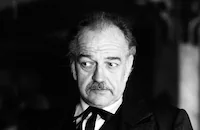An Enemy Of The People

Brief Synopsis
Cast & Crew
George Schaefer
Steve McQueen
Charles Durning
Bibi Andersson
Eric Christmas
Michael Cristofer
Film Details
Technical Specs
Synopsis
Dr. Thomas Stockmann learns that a tannery is responsible for polluting a hot spring in his town and feels a moral obligation to inform the community about it. But since several prominent citizens had planned on creating a health spa built around the springs, his brother Peter, the mayor, declares that a clean-up is unnecessary. Tom was one of the backers of the spa, but still thinks that the people need to know the truth. Although the town council tries to silence him, Tom speaks out. But public opinion has been turned against him, resulting in his medical practice being ruined and his marriage strained.
Director
George Schaefer
Cast

Steve McQueen

Charles Durning

Bibi Andersson
Eric Christmas
Michael Cristofer

Richard Dysart

Michael Higgins
Richard Bradford
Ham Larsen
John Levin
Robin Pearson Rose
Crew
Jack Aldworth
Henrik Ibsen
Alexander Jacobs
Sheldon Kahn
Michael J Kohut
Paul Lohmann
Eugene Lourie
Arthur Miller
Arthur Miller
Anthony Mondello
Leonard Rosenman
George Schaefer
Nick Taylor
Videos
Movie Clip



Film Details
Technical Specs
Articles
An Enemy of the People -
McQueen, who was also executive producer, personally shepherded the project from the beginning. For his director, he turned to George Schaefer, who had never made a feature film but had won seven Emmy Awards over twenty years for directing and producing TV dramas for Hallmark Hall of Fame and other prestigious television showcases. He brought in Alexander Jacobs, screenwriter of such tough, gritty films as Point Blank (1967) and French Connection II (1975), to develop the script from Arthur Miller's 1950 English adaptation of the play as well as a line-by-line translation of the original Norwegian text. And he set out to cast the best actors he could secure on the film's $2.5 million budget. "I said the picture couldn't be designed to protect a weak performance by him," said Schaefer, recalling his first meeting with McQueen. "He said he absolutely agreed."
Bibi Andersson, who had worked with Ingmar Bergman on both stage and screen, was cast as his wife and Nicol Williamson, fresh from Robin and Marian (1976) and The Seven-Per-Cent Solution (1976), was the doctor's brother, who is also the town's mayor. Williamson, however, was nowhere to be found on the first day of rehearsal (he was in Hawaii, they later discovered) and was quickly replaced by Charles Durning, a busy character actor who had delivered memorable performances in The Sting (1973) and Dog Day Afternoon (1975). Durning had heard stories that McQueen was short-tempered and difficult to work and was surprised to hit it off with the actor. "I found him to be loyal to the people he worked with, even defending them," he told McQueen biographer Marshall Terrill. Richard Dysart played the newspaper publisher and actor and future Pulitzer Prize-winning playwright Michael Cristofer made his feature debut as the editor, Hovstad.
According to his collaborators, McQueen addressed the cast on the first day of rehearsals. "To be absolutely honest, this material is more your world than mine. But I'm going to give it my all." He put on 30 pounds and grew a full beard for the role, and committed to three weeks of rehearsal before going before the cameras. And for an actor who hated learning lines and worked to cut his dialogue down to the minimum in earlier films, he dedicated himself to memorizing all of his speeches, including the climactic three-page monologue. "His performance grew tremendously during those three weeks," Durning told New York Times reporter Aljean Marmetz. "What I didn't expect was his generosity. He was honest, giving, and true to his character. He let you have the stage when it was your time." As Durning told Terrill, "The better you were, the more he applauded you."
The film was shot in the fall of 1976 and completed by February 1977, but languished on the shelf for years. Warners didn't know how to promote the film, a piece of classical theater starring an action superstar playing against the image he had carefully crafted over the past couple of decades. They test marketed the film in 1978 to fair attendance and lukewarm reviews. To audiences unfamiliar with the play, the title sounded more like a western than a serious drama, and McQueen's name above the title further confused expectations. On screen, he was unrecognizable under the bushy beard, long hair, and wire-rimmed glasses. "I did An Enemy of the People because I just wanted to do something that I felt was pure," McQueen said, and he took great pride in his achievement. But the film never received a wide release and the financial failure, which coincided with his divorce from McGraw, hit McQueen hard. He only made two more films, a western and an action picture, before his untimely death in 1980 at the age of 50.
Sources:
Steve McQueen: A Biography, Marc Eliot. Crown Archetype, 2011.
Steve McQueen: The Life and Legend of a Hollywood Icon, Marshall Terrill. Triumph, 2010.
"Steve McQueen Goes for Ibsen--But Hollywood Doesn't," Aljean Harmetz. The New York Times, April 15, 1979.
AFI Catalog of Feature Films
IMDb
By Sean Axmaker

An Enemy of the People -
Quotes
Trivia
'McQueen, Steve' wanted his wife Ali MacGraw to star opposite him, until they broke up just before production began.
Miscellaneous Notes
Released in United States 1978
Released in United States 1978













